- Home
- History
- Maps
- Treaty Forums
- Purpose of the Peace Treaty Forums
- Forum I Jun 1994
- Forum II Oct 1994
- Forum III Sep 1995
- Forum IV Mar 2000
- Forum V Dec 2006 TR Nobel 100th
- Forum VI Dec 2007 with Dennis Ross
- Forum VII Dec 2008 with Samantha Power
- Forum VIII Dec 2009 Obama's Nobel
- Forum IX Nov 2016 Russia-Japan
- Forum X Nov 2019 Jake Sullivan
- Forum XI Sep 2020 Joseph S. Nye Jr.
- Citizen Diplomacy
- Connections
- Spiritual Aspects
- 2005 100th Anniversary
- 2006 Nobel Prize 100th
- 2007 Commemorations
- 2008 Commemorations
- 2009 Commemorations
- 2010 Portsmouth Peace Treaty Day
- 2011 Order of the Rising Sun
- 2012 100 Years of Cherry Trees
- 2013 Historic Marker Dedicated
- 2014 Sister City Celebrations
- 2015 110th Anniversary
- 2016 Commemorations
- William Chandler & Concord, NH
- Kentaro Kaneko & Dublin, NH
- Asakawa, Dartmouth & Hanover NH
- Carey Family & Creek Farm
- Henry Denison & Lancaster, NH
- John Hay & Newbury, NH
- Japanese Visit Manchester, NH
- Wentworth & New Castle, NH
- Portsmouth: Temple Israel, Rev. Clark
- Sarah Farmer & Eliot, Maine
- Adm. Mead & Kittery, Maine
- Elizabeth Perkins & York, Maine
- Educational Resources
- Living Memorial Project
- Contact Us
- 1713 Treaty

Travel and Tragedy  Meanwhile, the
Meanwhile, the
In photo, the Clark children: Edith (rear), Henry (right), Robert (middle left), and Lucius (lower left) advertising "Clark's Tours Around the World." From Your Choice of Trips for 1897 by E. Warren Clark (Rockford, IL, 1897), courtesy Wisconsin Historical Society.
In December 1899 the local paper announced “two Japanese, Ishida and Kimura” were “in Rockford on invitation of Rev. E. Warren Clark” to “provide a pleasing entertainment at the State Street Baptist Church” with the familiar “stereopticon views of Japanese scenes, moving pictures, tableaux of the Mikado’s court, sword dance and other features.” Yet, it was also said that one was a lawyer and that Mr. Clark brought him here to use his best endeavor to persuade Mrs. Clark to sign certain legal papers, preliminary to a separation from his wife.” In 1900 his wife successfully sued for separate maintenance over of lack of support and two years later Clark sued in
Turn of the Century Wanderings
In the summers of 1902 and 1903, he ministered in

Suffering from “La Grippe” over the winter of 1904 Clark found himself the guest of Mr. James M. Munyon, a homeopathic patent medicine tycoon from
But in 1904, the Russo – Japanese War was bringing greater interest in
As he wrote on his return trip in Sept. 1904, "I have made a SUPERB collection of War Views and reliable photographs in  Stereopticon glass slides of the War.
Stereopticon glass slides of the War.
Returning to the
The
In December
Every cent was intended for the cause, as was over six months of Clark‘s unpaid time. Meanwhile, a published appeal for “the big fund” was sent to 33,000 churches and Sunday schools across the country in the two weeks before Christmas. According to the appeal, those funds would be “cabled for distribution to Bishop Harris,
Methodist Bishop of
A letter to the New York Times by S.P. Franks criticized the appeal, noting there “is no reason the Russians starving do not deserve the help of the Americans as much as the Japanese do. . . .. Let the many benevolent Christian organizations of this country do the same for their Russian fellow Christians.” So on December 20, a revised appeal in the Times noted the group now sought “contributions in aid of the sick and wounded of both Japanese and Russian armies and of widows and orphans in
On January 20, 1905 Charles Cuthbert Hall, president of the Union Theological Seminary, wrote Griff that, “The Japanese Relief Fund has been a little slow but I think is going to be started in a day or two and will be effective.” The Rector of New York’s Grace Church, the Rev. W. R. Huntington, also apologized for not getting the circulars in the mail before Christmas. “The one thing that reconciles me to the delay, “ he wrote, “Is the intelligence from the east with respect to the Russian soldiers surrendered at
In February Clark received a letter from Mrs. Clara Whitney Kaji (wife of Katz Awa’s son) promoting the idea that he offer a paying lecture at the Brooklyn Institute of Arts and Science, with “Tableaux-Vivante, war pictures and Bioscope Motion-Pictures.” His title was “From Shidz-u-o-ka Feudalism to the Fall of Port Arthur.” Just before Easter, an appeal went out to churches across the land offering his Katz Awa book. The money was mailed to the publisher, with “checks, money orders or remittances independent of the booklet” to be sent to the Orphan Fund in
Next: Scandal
© Copyright 2005 Japan-America Society of New Hampshire
NH Web Design | Content Management | Web Hosting